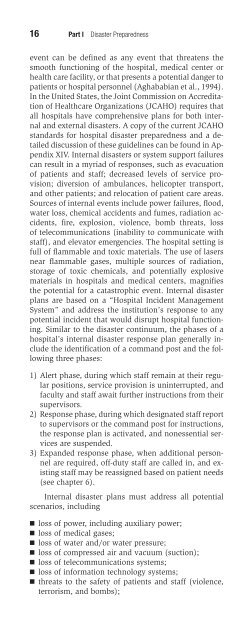Disaster Nursing and Emergency Preparedness - Springer Publishing
Disaster Nursing and Emergency Preparedness - Springer Publishing
Disaster Nursing and Emergency Preparedness - Springer Publishing
You also want an ePaper? Increase the reach of your titles
YUMPU automatically turns print PDFs into web optimized ePapers that Google loves.
16 Part I <strong>Disaster</strong> <strong>Preparedness</strong><br />
event can be defined as any event that threatens the<br />
smooth functioning of the hospital, medical center or<br />
health care facility, or that presents a potential danger to<br />
patients or hospital personnel (Aghababian et al., 1994).<br />
In the United States, the Joint Commission on Accreditation<br />
of Healthcare Organizations (JCAHO) requires that<br />
all hospitals have comprehensive plans for both internal<br />
<strong>and</strong> external disasters. A copy of the current JCAHO<br />
st<strong>and</strong>ards for hospital disaster preparedness <strong>and</strong> a detailed<br />
discussion of these guidelines can be found in Appendix<br />
XIV. Internal disasters or system support failures<br />
can result in a myriad of responses, such as evacuation<br />
of patients <strong>and</strong> staff; decreased levels of service provision;<br />
diversion of ambulances, helicopter transport,<br />
<strong>and</strong> other patients; <strong>and</strong> relocation of patient care areas.<br />
Sources of internal events include power failures, flood,<br />
water loss, chemical accidents <strong>and</strong> fumes, radiation accidents,<br />
fire, explosion, violence, bomb threats, loss<br />
of telecommunications (inability to communicate with<br />
staff), <strong>and</strong> elevator emergencies. The hospital setting is<br />
full of flammable <strong>and</strong> toxic materials. The use of lasers<br />
near flammable gases, multiple sources of radiation,<br />
storage of toxic chemicals, <strong>and</strong> potentially explosive<br />
materials in hospitals <strong>and</strong> medical centers, magnifies<br />
the potential for a catastrophic event. Internal disaster<br />
plans are based on a “Hospital Incident Management<br />
System” <strong>and</strong> address the institution’s response to any<br />
potential incident that would disrupt hospital functioning.<br />
Similar to the disaster continuum, the phases of a<br />
hospital’s internal disaster response plan generally include<br />
the identification of a comm<strong>and</strong> post <strong>and</strong> the following<br />
three phases:<br />
1) Alert phase, during which staff remain at their regular<br />
positions, service provision is uninterrupted, <strong>and</strong><br />
faculty <strong>and</strong> staff await further instructions from their<br />
supervisors.<br />
2) Response phase, during which designated staff report<br />
to supervisors or the comm<strong>and</strong> post for instructions,<br />
the response plan is activated, <strong>and</strong> nonessential services<br />
are suspended.<br />
3) Exp<strong>and</strong>ed response phase, when additional personnel<br />
are required, off-duty staff are called in, <strong>and</strong> existing<br />
staff may be reassigned based on patient needs<br />
(see chapter 6).<br />
Internal disaster plans must address all potential<br />
scenarios, including<br />
■ loss of power, including auxiliary power;<br />
■ loss of medical gases;<br />
■ loss of water <strong>and</strong>/or water pressure;<br />
■ loss of compressed air <strong>and</strong> vacuum (suction);<br />
■ loss of telecommunications systems;<br />
■ loss of information technology systems;<br />
■ threats to the safety of patients <strong>and</strong> staff (violence,<br />
terrorism, <strong>and</strong> bombs);<br />
■ toxic exposures involving fumes, chemicals, or radiation;<br />
■ immediate evacuation of all patients <strong>and</strong> personnel.<br />
Internal disaster plans should be integrated with the<br />
hospital’s overall disaster preparedness protocol. Training<br />
should be m<strong>and</strong>atory for all personnel. As with other<br />
disaster plans, drills should be designed <strong>and</strong> routinely<br />
performed to ensure that all staff are adequately prepared<br />
(see chapter 6 for a detailed discussion of the<br />
management of internal disasters).<br />
Bioterrorism/Communicable Disease<br />
Infectious disease outbreaks create unique challenges<br />
to planners. At what point does outbreak management<br />
become disaster management? The investigation <strong>and</strong><br />
management of any communicable disease outbreak requires<br />
three steps: (a) recognition that a potential outbreak<br />
is occurring; (b) investigation of the source, mode<br />
of transmission, <strong>and</strong> risk factors for infection; <strong>and</strong> (c)<br />
implementation of appropriate control measures. If outbreak<br />
management exceeds or threatens to exceed the<br />
capability <strong>and</strong> resources of the institution, then a disaster<br />
management model may be useful (Moralejo, Russell,<br />
& Porat, 1997).<br />
Institutional outbreaks of communicable disease<br />
are common. Most institutional outbreaks involve relatively<br />
few cases with minimum effect on the hospital<br />
<strong>and</strong> external community. However, large outbreaks, outbreaks<br />
of rare diseases, smaller outbreaks in institutions<br />
lacking infection control departments, or outbreaks in<br />
those with inadequate infection control personnel may<br />
exceed an institution’s or a community’s coping capacities<br />
(Moralejo et al., 1997). The need for widespread<br />
quarantine for the purposes of disease control (e.g.,<br />
smallpox epidemic) would rapidly overwhelm the existing<br />
health care system <strong>and</strong> create significant staffing<br />
issues. Staff may refuse to come to work, fearing exposure<br />
to themselves <strong>and</strong> their families. Health care facilities<br />
play a vital role in the detection <strong>and</strong> response to<br />
biological emergencies, including new emerging infections,<br />
influenza outbreaks, <strong>and</strong> terrorist use of biological<br />
weapons. Assessment of the preparedness <strong>and</strong> capacity<br />
of each hospital to respond to <strong>and</strong> treat victims of an<br />
infectious disease outbreak or biological incident must<br />
be conducted as part of disaster planning. The Agency<br />
for Healthcare Research <strong>and</strong> Quality (AHRQ, 2002) released<br />
a survey tool that was widely used by hospitals<br />
<strong>and</strong> health care facilities to assess their capacity to h<strong>and</strong>le<br />
potential victims of bioterrorist attacks. In 2006, the<br />
Agency for Healthcare Research <strong>and</strong> Quality issued a<br />
report entitled “Altered St<strong>and</strong>ards of Care in Mass Casualty<br />
Events” with respect to bioterrorism <strong>and</strong> other<br />
public health emergencies (AHRQ, 2005).

















